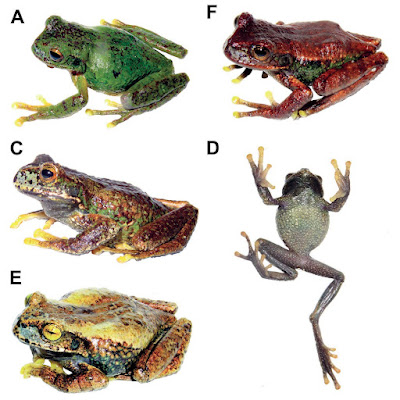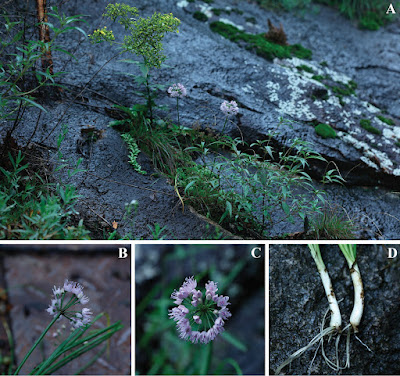[Most Recent Entries] [Calendar View]
Saturday, February 19th, 2022
| Time | Event | ||||||
| 2:08a | [Herpetology • 2022] Gastrotheca flavodactyla & G. trachyplevra • Two New Species of Marsupial Frogs (Anura: Hemiphractidae) from the Central Andes of northern Peru
Abstract We describe two new species of Gastrotheca from the humid montane forests and grasslands of La Libertad and Amazonas departments, respectively, in the northern portion of the central Peruvian Andes. Our phylogenetic analysis recovered the new species as part of the Gastrotheca marsupiata species group and closely related to G. gemma, G. oresbios, G. psychrophila, G. spectabilis, G. stictopleura, and one undescribed species. The new species from La Libertad department can be differentiated from the aforementioned congeners by being of moderately small size (SVL = 33.3–41.9 mm, N = 3), having an acutely rounded snout in dorsal view, a rounded snout in lateral view, smooth skin on the dorsum with low granules, and smooth tympanic annulus and supratympanic fold. The new species from Amazonas department (SVL = 33.5–43.9 mm, N = 2) differs from other Gastrotheca species by having the dorsum covered with large and closely packed rounded pustules, two prominent paravertebral longitudinal pustular ridges, and a distinctly thick and elevated supratympanic fold extending from the top edge of the tympanum to the flank and being continuous or fused with the dorsolateral row of elongated pustules. In addition to external morphological characters, we include detailed descriptions and illustrations of the skeleton of the holotypes based on 3D models obtained from CT-scans. Key words. Amphibia, CT-scan, Gastrotheca, osteology, phylogeny, taxonomy. Gastrotheca flavodactyla sp. n. Diagnosis. Assigned to the genus Gastrotheca due to its phylogenetic placement in our results. The two unambiguous phenotypic synapomorphies proposed for the genus (Castroviejo-Fisher et al. 2015) – the presence of an enclosed pouch with a posterior opening in adult females, and two fused pairs of bell-shaped gills derived from Branchial arches I and II in embryos – correspond to semaphoronts not available for this study. A moderately small species (SVL between 33.3 and 41.9 mm in adult males) with: (1) snout acutely rounded and rounded in dorsal and lateral views, respectively; (2) canthus rostralis slightly concave; (3) loreal region concave; (4) tibia length 53–55% of SVL, slightly longer than foot; (5) interorbital distance almost twice the width of the upper eyelid; (6) skin on dorsum smooth with low granules, skull not co-ossified, but adherent with it above, lacking transverse ridges; (7) supraciliary processes absent; (8) tubercles on heel present, low; (9) tympanic annulus smooth; (10) nuptial pad present, oval; (11) vocal sac not evident externally; (12) Finger I slightly shorter than Finger II, discs wider than digits; (13) webbing between fingers basal; (14) foot webbing basal, extending to penultimate subarticular tubercle on the postaxial side of Toes II (2) and III (2+) and on the preaxial side of Toe V (2+); (15) dorsum green or brown with spots, blotches or wide dorsolateral stripes, dorsal surface of finger and toe pads yellow; (16) dark brown or black blotches (melanophores) forming a broad and discontinuous vertebral stripe extending from interorbital region to above the cloaca, more evident in preserved specimens; (17) dorsolateral stripe absent; (18) flanks green with or without black or brown blotches, or golden spots; (19) gular region yellow with dense black reticulation or uniformly black; venter yellow with a diffuse light green spot and melanophores in the middle or greyish cream; ventral surface of thighs black or dark grey; palms and soles black or dark grey due to abundant melanophores, which extend to all ventral surfaces of fingers and toes but are more abundant on Fingers III and IV, and Toes III and IV; (20) iris copper-red or yellow with black reticulation. Females unknown, for which reason the brood pouch opening and reproduction mode, two characters often used in Gastrotheca species diagnosis, are unknown as well. Distribution and natural history. Gastrotheca flavodactyla is known so far only from Cruz Grande and Laguna Secseragra, at 3298 and 3336 m a.s.l. respectively, in La Libertad department. These localities are less than 1 km apart and lie in the humid montane forest of the headwaters of the Abiseo River, Cordillera Central Páramo ecoregion (Olson et al. 2001), in the northern portion of the Central Andes (Fig. 7). All specimens were found inactive under stones along the edge of a road at the transition between elfin forest and grassland between 14:20 and 17:00 hours, where they seemed to be resting. Etymology. The specific epithet combines the Latin word flavo, an adjective meaning “yellow”, and the Greek word dáchtyla, a noun meaning “fingers”. This specific name is used in apposition and refers to the yellow finger and toe pads of the new species in life. Gastrotheca trachyplevra sp. n. Diagnosis. Assigned to the genus Gastrotheca by the presence of a closed brood pouch on the dorsum of the only known adult female, and its phylogenetic placement in the genus. A moderately small species (43.9 mm SVL in one female, 33.5 mm SVL in one male) with: (1) snout rounded and inclined anteroventrally in dorsal and lateral views, respectively; (2) canthus rostralis concave; (3) loreal region concave; (4) tibia length 40−41% of SVL, slightly shorter than foot; (5) interorbital distance less than twice the width of upper eyelid; (6) dorsum covered with large and closely packed rounded pustules and two prominent paravertebral longitudinal pustular ridges, skin not co-ossified with skull; (7) supraciliary processes absent; (8) small rounded tubercles on heel present; (9) tympanic annulus smooth; (10) nuptial pad present, oval; (11) vocal sac not evident externally; (12) Finger I longer than Finger II, discs barely wider than digits; (13) fingers unwebbed, basal webbing only between Fingers II and III; (14) toe webbing basal, extending to penultimate subarticular tubercle on preaxial (2+) and postaxial (2−2- ) sides of Toe II, on postaxial side of Toe III (2+), and on preaxial side of Toe V (2+); (15) female dorsal coloration light brown with black and dark brown blotches; male dorsal coloration green with brown blotches; (16) male and female’s head markings consisting of small brown blotches; (17) dorsolateral stripe absent; (18) flanks with the same coloration and pattern as the dorsum; (19) gular region dull white in female and golden in male, venter dull white with a pink or light orange hue over the posterior edge in female and male, respectively, ventral surface of thighs red, brighter in the female, and greyish towards the knee, palms and soles grey with reddish and yellowish hues in female and male, respectively; (20) iris dark brown with a few golden specks and a golden pupillary ring; (21) brood pouch single, dorsal, with a V-shaped opening; (22) direct development of embryos into froglets. Etymology. The specific epithet results from combining the Greek words trachýs, an adjective meaning “rugose”, and plevrá, a noun meaning “flank”. This specific name is used in apposition and refers to a distinctive feature of the new species, the rugose flanks full of pustules. Lourdes Y. Echevarría, Daniel J. Paluh, Luis A. García-Ayachi, Pablo J. Venegas, Alessandro Catenazzi, Renzo Pradel and Santiago Castroviejo-Fisher. 2022. Two New Species of Marsupial Frogs (Anura: Hemiphractidae) from the Central Andes of northern Peru. SALAMANDRA. 58(1); 1–23. | ||||||
| 10:39a | [Botany • 2022] Allium heterophyllum (Amaryllidaceae) • A New Species from Henan, China
Abstract Allium heterophyllum D.F.Xie & X.J.He, sp. nov. (Amaryllidaceae), is a new species from Henan, China and is described based on morphological and molecular evidence. It is morphologically most similar to A. dumebuchum in the rhomboid scape in cross-section. However, distinctive differences were detected in perianth color, leaf shape and cross-section, flowers’ density as well as flowering season. Similarly, the karyotype of A. heterophyllum is 2n = 2x = 16 and in A. dumebuchum is 2n = 4x = 32. Phylogenetic analysis based on nuclear ribosomal Internal Transcribed Spacers (ITS) and three cpDNA regions strongly supports that A. heterophyllum is a member of Allium section Rhizirideum and sister to the other species of this section (e.g. A. senescens, A. spirale, and A. prostratum). Currently, only one population and approximately 120 individuals were discovered; the development of scenic spots in this region may affect its growth and threaten this population. Therefore, this new species is preliminarily considered as Near Threatened (NT) according to criteria of the IUCN Red List. Keywords: Allium, chromosome number, morphology, new species, phylogenetic analysis
Allium heterophyllum D.F.Xie & X.J.He, sp. nov. Diagnosis: Allium heterophyllum resembles A. dumebuchum due to its rhomboid scape in cross-section. However, it is clearly distinguished from A. dumebuchum in perianth (white to light purple vs. light purple), leaves (not tortuous and not flesh vs. slight tortuous and flesh), the cross-section of leaves (two types vs. one type), flowers’ density (loose inflorescence vs. many-flowered) (Fig. 2; Table 2), flowering season (late August to September vs. late September to October), and karyotype (2n = 16 vs. 2n = 32) (Fig. 4). Compared to other Rhizirideum species (e.g., A. scenescens, A. spirale and A. spurium), A. heterophyllum also shows distinctive morphological characters, such as rhomboid scape in cross-section, unique two types of leaves, loose flowers, white to light purple color of perianth and filaments, and flowering season. Habitat and ecology: Currently, A. heterophyllum is only known from the type population in Longchiman Mountains in Songxian County, Henan, China. This species grows on the open slope of rock by the river with a small amount of soil attached, sometimes rooting in crevices, holes or steps of the rock face at an elevation from 1250 m to 1400 m. Etymology: The new species epithet “heterophyllum” is based on the unique leaves’ characters, its leaves exposed two types of morphologies, canaliculated with one bulge in the back or flat with irregularly one or two-edged margin, and the differences in the leaves are most obvious in flowering and fruit periods. (Fig. 2). Chinese name: Yi Ye Jiu (异叶韭). Deng-Feng Xie, Rui-Yu Cheng, Megan Price, Jun-Pei Chen, Jia-Qing Lei, Yi-Yang Zhang and Xing-Jin He. 2022. Allium heterophyllum (Amaryllidaceae), A New Species from Henan, China. PhytoKeys 190: 53-67. DOI: 10.3897/phytokeys.190.77449 |
| << Previous Day |
2022/02/19 [Calendar] |
Next Day >> |









